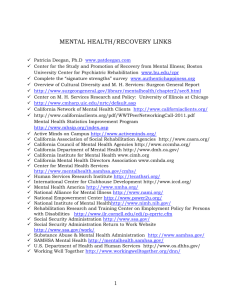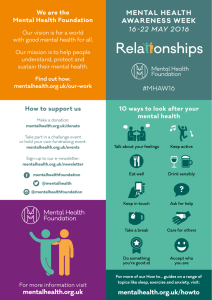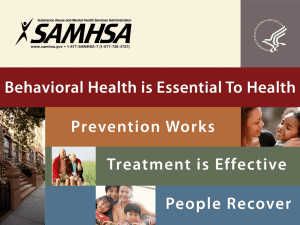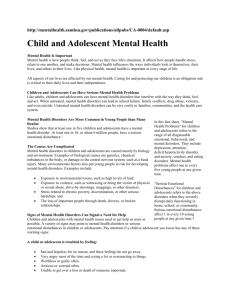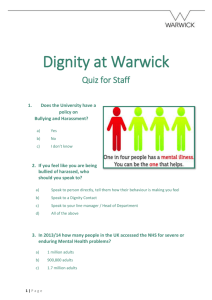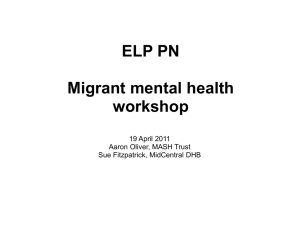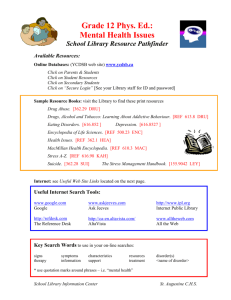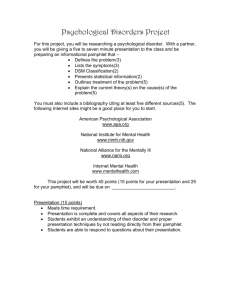Impact of Mental Illness and Special Needs on Students Mental Health
advertisement
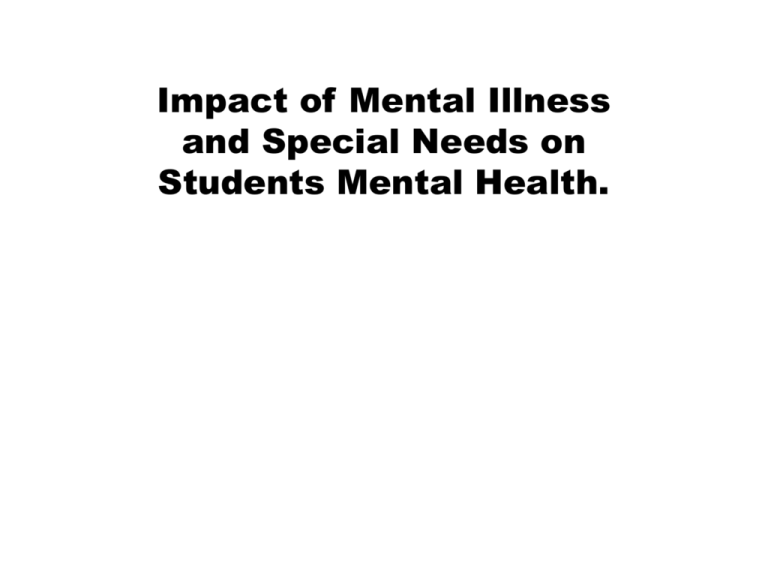
Impact of Mental Illness and Special Needs on Students Mental Health. Agenda • • • • • • What is Mental Health? Who are we talking about? The Numbers. Mental Illness and Special Needs The Impact. How do we Help? What is Mental Health • Mental health is how people think, feel, and act as they face life's situations. It affects how people handle stress, relate to one another, and make decisions. Mental health influences the ways individuals look at themselves, their lives, and others in their lives. Like physical health, mental health is important at every stage of life. • All aspects of our lives are affected by our mental health. • Department of Health and Human Services National Mental Health Information Center (www.mentalhealth.samhsa.gov) Mental Health • Mental Health is the capacity of each and all of us to feel, think and act in ways that enhance our ability to enjoy life and deal with the challenges we face. It is a positive sense of emotional and spiritual well being that respects the importance of culture, equity, social justice, interconnections and personal dignity. (MHPU, Kids • Spanning roughly 20 years, childhood and adolescence are marked by dramatic changes in physical, cognitive, and socialemotional skills and capacities. (Surgeon General, 1999) Kids • ‘You have to have chaos within you to give birth to a dancing star’ • Friedrich Nietzsche Chaos? • • • • • • • Growth and development Peer relationships family roles and relationships ethical/moral development developing identity achievement pressure sexuality, puberty Kids Mental Health • ‘Mental health in childhood and adolescence is defined by the achievement of expected developmental cognitive, social, and emotional milestones and by secure attachments, satisfying social relationships, and effective coping skills. Mentally healthy children and adolescents enjoy a positive quality of life; function well at home, in school, and in their communities; and are free of disabling symptoms of psychopathology’ (Surgeon General, 1999) The Numbers • ‘Studies show that at least one in five children and adolescents have a mental health disorder. At least one in 10, or about 6 million people, have a serious emotional disturbance.’ (www.mentalhealth.samhsa.gov) The Numbers cont’d • Approximately one in five children and adolescents experiences the signs and symptoms of a DSM-IV disorder during the course of a year, but only about 5 percent of all children experience what professionals term “extreme functional impairment. • Mental Health: A report of the Surgeon General. (http://www.surgeongeneral.gov/library/ mentalhealth/toc.html) OSDUS 2005 • Grade 7-12 within last 12 months • 12% reported a visit to a mental health professional • 2-4% used prescribed meds for mental health reasons • 2% reported using crisis line • 10% reported low self esteem (11% female vs. 8% male) OSDUS cont’d • 30% reported increased psychological distress • Losing sleep over worry 19% • Feeling constantly under stress 28.7% • Feeling unhappy 12.5% • Unable to overcome difficulties 12.7% • Losing self confidence 11.1% • Unable to concentrate 10.2% • Think they’re worthless 9.4% • Unable to enjoy daily activities 9.6% OSDUS cont’d • Unalbe to face problems 8.9% • Not feeling useful 8.3% • Incapable of making decesions 5.7% OSDUS cont’d • Seriously considered suicide 11% (female 16% vs. 7% male) • 113800 Ontario students • Where to go? Mental Illness and Special needs • • • • NIMH Mental Help Net Internet Mental Health The Learning Disabilities Association of Canada Impact • ‘Like adults, children and adolescents can have mental health disorders that interfere with the way they think, feel, and act. When untreated, mental health disorders can lead to school failure, family conflicts, drug abuse, violence, and even suicide. Untreated mental health disorders can be very costly to families, communities, and the health care system’ (www.mentalhealth.samhsa.gov) Impacts • Externalizing behaviours: delinquent, violent, fire setting, bullying, substance misuse, gambling, etc (OSDUS, 2005) How do we Help • Fight Stigma by education and listening • Fight Stigma by talking and early identification • Fight Stigma by providing perspective • More Early Risk Identification • Know your local rewources References • Public Health Agency of Canada Mental Health Promotion Unit (http://www.phac-aspc.gc.ca/mhsm/mentalhealth/mhp/index.html) • World Health Organization (http://www.who.int/en) References • Department of Health and Human Services National Mental Health Information Center (www.mentalhealth.samhsa.gov) • Internet Mental Health (www.mentalhealth.com) • Mental Help Net (mentalhelp.net) • NIMH (nimh.nih.gov) • The Learning Disabilities Association of Canada (www.ldac-taac.ca) References • Centre for Addiction and Mental Health. Ontario Student Drug Use Survey . http://www.camh.net/research/osd us.html • United States Department of Health and Human Services National Mental Health Information Center www.mentalhealth.samhsa.gov
